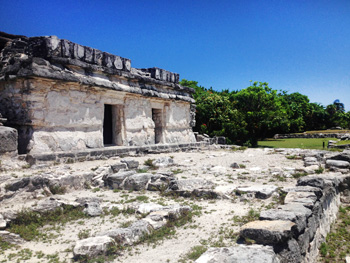
by Zach Lindsey
A postclassic Maya temple in Cancún looks to the south, across a road full of microbuses and hot red cars with inebriated passengers, across a golf course, across a line of trees, into a secluded cluster of ruins called El Rey.
El Rey and San Miguelito are archaeological sites that are less than two kilometers apart on the main drag of one of the most heavily-trafficked tourist communities in the world, yet there are cab drivers and city bus drivers that don’t know where they are.
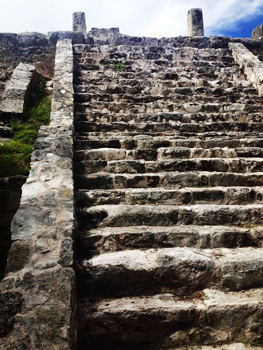 There are many good reasons to go to Cancún: a long, relaxing break from a stressful job, a way of visiting other cities in Quintana Roo and Yucatán like Tulúm or Mérida, a chance to renew your visa if you’re living abroad and you need an immigration office that is used to dealing with the weird errors American tourists are capable of making while filling out paperwork.
There are many good reasons to go to Cancún: a long, relaxing break from a stressful job, a way of visiting other cities in Quintana Roo and Yucatán like Tulúm or Mérida, a chance to renew your visa if you’re living abroad and you need an immigration office that is used to dealing with the weird errors American tourists are capable of making while filling out paperwork.
Learning about ancient Maya culture is not usually listed as one of them. Cancún is a city without history, a place where Mexican financers were allowed to build a completely Mexican city without colonial Spanish architectural influences. They picked a location with an incredible view of the Caribbean, sandy beaches, and forests of mangrove trees. Virgin territory.
But not quite virgin.
It’s no surprise the Maya built stone structures on the island that is now Cancún’s hotel district; on the less-developed portions of the island, there is still a beauty in the sharp contrast between green vegetation and tan sand. As Maya Research Program archaeologist Mark Wolf once said, “The ancient Maya were just like us. They liked a room with a view.”
When planners designed the main street that runs through the hotel district in Cancún, Boulevard Kukulkan, they were faced with the ruins of these structures and evidence of long-gone wooden houses between them. To the west of that was the lagoon separating the island of Cancún from the mainland. To the east was the temperamental Caribbean with its potential for flooding and violent hurricanes.
They decided to go down the middle.
The ruins on one side of the road are named San Miguelito; the ruins on the other side are El Rey. It’s hard to know for sure if they represent closely linked but separate cities or complexes from the same city.
There is one big clue, though: the pyramid at San Miguelito.
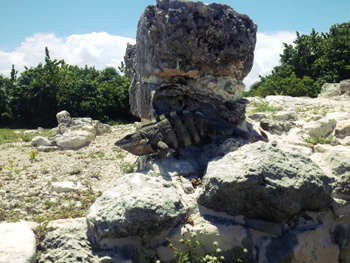 Curiously, this temple faces away from the other stone buildings at San Miguelito. Instead, it faces El Rey. Between the pyramid and El Rey, there may have been an uninterrupted stretch of houses and other structures. Unfortunately, “low level houses were not registered during the design and construction phase of the hotel zone during the seventies,” according to a National Institute of History and Anthropology (INAH) placard at San Miguelito.
Curiously, this temple faces away from the other stone buildings at San Miguelito. Instead, it faces El Rey. Between the pyramid and El Rey, there may have been an uninterrupted stretch of houses and other structures. Unfortunately, “low level houses were not registered during the design and construction phase of the hotel zone during the seventies,” according to a National Institute of History and Anthropology (INAH) placard at San Miguelito.
Online, INAH mentions that San Miguelito extended for three kilometers and includes “the current archaeological site of El Rey.” This might be backwards, since El Rey seems to be the older of the two sites. Either way, this information isn’t at the sites.
The Maya first started developing at El Rey probably around 300 BCE. For many years, it was a stable but sleepy fishing town. It wasn’t until centuries later when coastal trade and an increased emphasis on the Yucatán peninsula allowed them to get rich. The extant structures at El Rey mostly date to the Late Postclassic era (from 1250 CE to the arrival of the Spaniards); all the structures at San Miguelito popped up around this time.
INAH claims the population did not increase during this boom, but it’s hard to know for sure without the houses destroyed and unrecorded by developers. Still, what is left today could be used in a textbook to discuss Postclassical Maya culture in the region. And whether they are one old city or two, the two archaeological sites of San Miguelito and (especially) El Rey are usually surprisingly peaceful and free of visitors.
Perhaps the most obvious characteristic of the two sites is the use of circular columns to support flat ceilings. Before the introduction of columns in the Postclassical Era and in Yucatán, the Maya used tapering false arches, and their rooms were inevitably tiny as a result.

Square columns are well-known in the Yucatán region, like at Chichén Itzá, and may be of Toltec origin. But the Maya of this region used carefully-rounded stone to create circular columns, an aesthetic choice that is still evocative as their shattered remnants rest, sometimes crooked, on settling, cracked foundations.
Columns allowed the Maya to build a sprawling building at San Miguelito called Chaak Palace by archaeologists. Chaak is the god of rain; symbols likely representing him appear on the staircase leading up to the seven-room palace. The palace itself was likely used for ceremonies and banquets, with its large central room and two temples. Priests or nobility may have also lived on the premises, as the remainder of the palace rooms appears to be homes.
They may have walked the short path between the palace and the back of the pyramid, stopping first at a small, two-roomed structure with rich murals of fish and other sea creatures to prepare. This might have meant steaming in a sauna or even cutting themselves to draw blood for the gods. You can still see the foundations and the bottom of the fading mural of this small structure at San Miguelito today.
Then, they would have walked up the pyramid to stand in the temple on the top and address city residents. Likely, they would have viewed the bustle in the slightly older buildings at El Rey from up so high.
Today, the ruins of El Rey are at kilometer 18, across the street (and yes past the golf course; try to keep your snickering and cynical commentary to yourself for a moment).
Perhaps the most well-known structure there is a well-preserved two-door temple with the smooth rectangular walls and decorative band of carved stone beginning a foot or two over the doorways. It could be used in a textbook to describe the architectural style known as costa oriental (‘east coast,’ which is what coast Cancún is on). You will see again if you go on to visit Tulúm, Muyil, or a dozen other sites in Yucatán. In other places, temples like this one have images of the descending god, who is usually associated with honey.
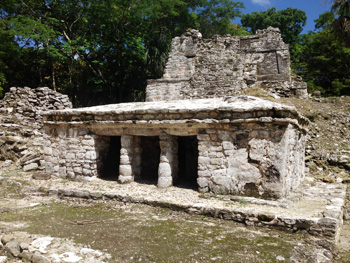 Most of these buildings as we see them date to the Postclassical era, but like most Maya structures, they were built in phases. The costa oriental temple had at least two construction phases. The pyramid at San Miguelito had at least three.
Most of these buildings as we see them date to the Postclassical era, but like most Maya structures, they were built in phases. The costa oriental temple had at least two construction phases. The pyramid at San Miguelito had at least three.
These building phases often seem like wrapped gifts to archaeologists: dig through one layer and find the next, even better-preserved, underneath it. Three phases is perhaps a lot for a relatively new, small pyramid like the one at San Miguelito, another sign of the financial success of the people who once lived here.
In truth, the ruins are hardly unknown on the Internet, but they are not frequently visited. This may be because travelers going on to other parts of Mexico imagine bigger temples and travelers staying in Cancún imagine nothing more than relaxation. They represent a lost city only in the sense that, in the haste to develop Cancún, parts of its identity were swept away. What was one became two.
Lots of people say Cancún doesn’t have a history, but the ruins prove it does. Before it was a tourist spot, before it was the site of haciendas, before there was a Mexico, this area was a vibrant trade hub for the cultures of Mesoamerica, probably even a seat of regional power.
If You Go:
♦ To see the ruins, start at the Cancún Maya Museum early in the day (the ruins close earlier than the rest of the museum, as I found out the hard way). Later, take a bus or taxi up to El Rey. Ask to get off at Kilometer 18. Not too far across the street is a nice public beach. Make sure to do the beach last, because an afternoon on a Cancún beach will make you far too lazy for this trip.
♦ If you see only one set of ruins on your trip to the Yucatán region, San Miguelito and El Rey probably shouldn’t be it. There are better preserved, better restored and better presented ruins on the Yucatán peninsula, like Coba, Uxmal, or Ek Balam. But if you plan to see a few, or you’ll be staying exclusively in Cancún, El Rey and San Miguelito are essential.
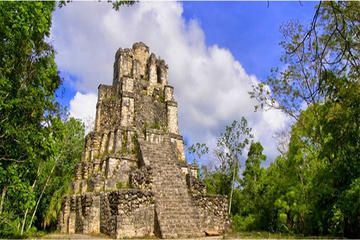
Private Tour to Muyil Ruins, Tulum and Coba from Cancun
About the author:
Zach Lindsey is an Irish-American English as a Second Language instructor and student of historical linguistics. He is interested in the way architecture, stonework, and murals communicate cultural values. You can see more photos of art and architecture he’s seen on his journeys on Arqueogato.tumblr.com.
All photos are by Zach Lindsey:
The costa oriental-style temple at El Rey.
The stairway of the pyramid at San Miguelito which faces towards El Rey.
One of the inheritors of the ocean-front view at El Rey, an iguana.
Columns at El Rey
Another costa oriental-style temple, this one at Muyil a few hours to the south.





Leave a Reply
You must be logged in to post a comment.